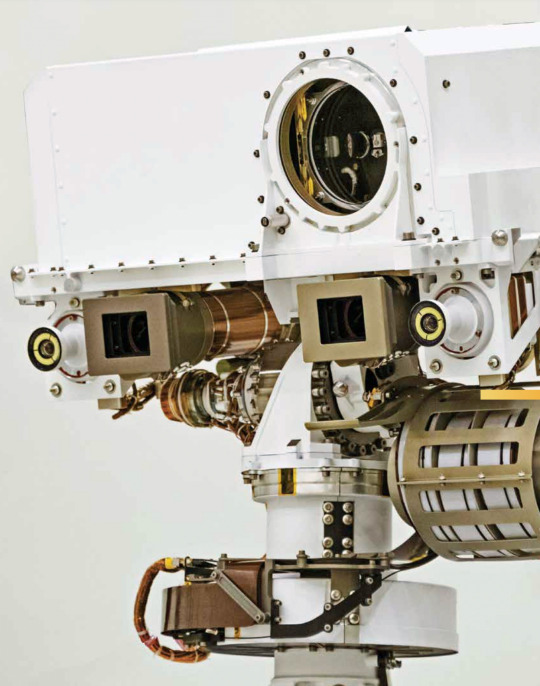#Perseverance (Mars 2020 Rover)
Photo

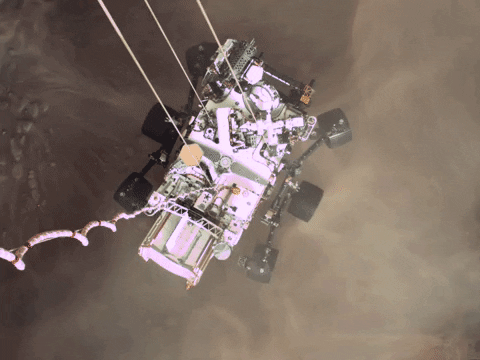
Landing of NASA’s Perseverance Mars rover
#go for queue deploy#nasa#mars#rover#perseverance#mars rover#nasa gif#mars 2020#mars landing#nasa mars#nasa perseverance#robot#robotics#astrobiology#Space and Astronomy#space#spaceflight#space exploration#space travel#mars exploration#science#technology#stem#nasa mars2020#gif
159 notes
·
View notes
Text


what’s that did someone ask for more martians? i think someone asked for more martians.

#lizart#curiosity#ingenuity#perseverance#gijinka#space#my ocs#mars 2020#curiosity rover#perseverance rover#mars helicopter#ingenuity helicopter#mars#nasa#17776 oc#17776
12 notes
·
View notes
Text

My mars gremlins,,,
#mars rovers#mars rover#curiosity#curiosity rover#mars 2020#perseverance#perseverance rover#percy#ingenuity#ginny#opportunity rover#oppy#zhurong#my art#art#artists on tumblr#personification#nasa#mars
47 notes
·
View notes
Text

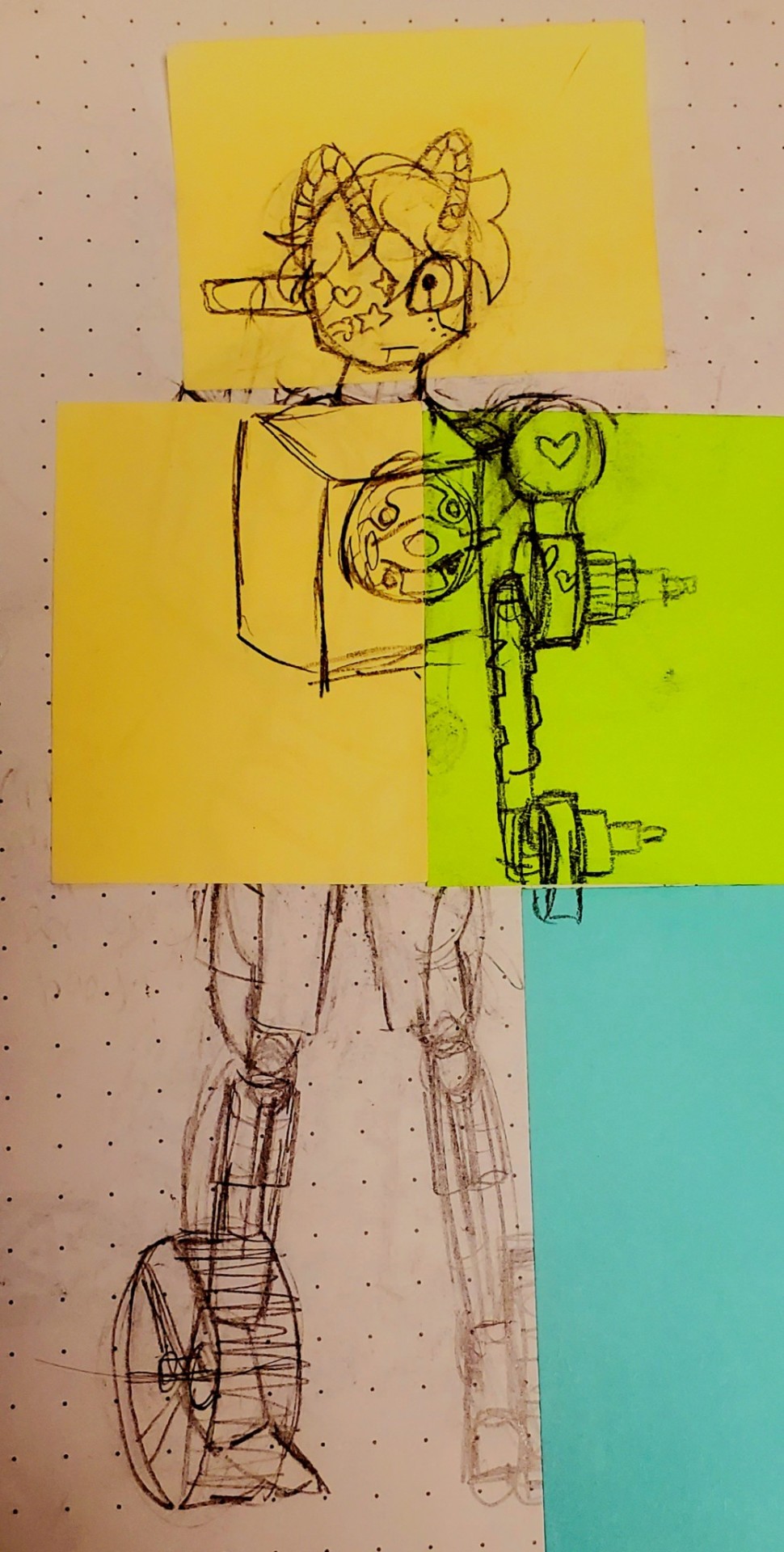

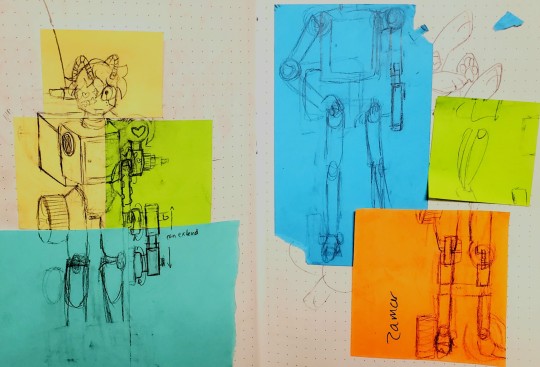
ive been trying to design the perseverance rover. its not going well
#perseverance rover#spacecraft#mars rover#mars 2020#robots#androids#my art#sketchbook#oc art#perse#gjinka#sticky notes#my issue is that i dont want it look like im stealing from someone else's design but having one base inspiration#its prolly inevitable? urg#wip
15 notes
·
View notes
Text
Today's the 2 year anniversary of Perseverance landing on Mars!
Happy Birthday, Percy!
#perseverance rover#perseverance#mars 2020#2020 rover#mars rover#happy birthday#happy birthday percy#mars
10 notes
·
View notes
Link
3 min read Comet Geyser: Perseverance’s 24th Rock Core Mastcam-Z image (Sol 1088, zcam0506...
0 notes
Text

What We Learned from Flying a Helicopter on Mars
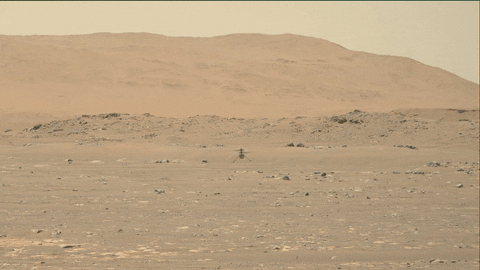
The Ingenuity Mars Helicopter made history – not only as the first aircraft to perform powered, controlled flight on another world – but also for exceeding expectations, pushing the limits, and setting the stage for future NASA aerial exploration of other worlds.
Built as a technology demonstration designed to perform up to five experimental test flights over 30 days, Ingenuity performed flight operations from the Martian surface for almost three years. The helicopter ended its mission on Jan. 25, 2024, after sustaining damage to its rotor blades during its 72nd flight.
So, what did we learn from this small but mighty helicopter?
We can fly rotorcraft in the thin atmosphere of other planets.
Ingenuity proved that powered, controlled flight is possible on other worlds when it took to the Martian skies for the first time on April 19, 2021.
Flying on planets like Mars is no easy feat: The Red Planet has a significantly lower gravity – one-third that of Earth’s – and an extremely thin atmosphere, with only 1% the pressure at the surface compared to our planet. This means there are relatively few air molecules with which Ingenuity’s two 4-foot-wide (1.2-meter-wide) rotor blades can interact to achieve flight.
Ingenuity performed several flights dedicated to understanding key aerodynamic effects and how they interact with the structure and control system of the helicopter, providing us with a treasure-trove of data on how aircraft fly in the Martian atmosphere.
Now, we can use this knowledge to directly improve performance and reduce risk on future planetary aerial vehicles.

Creative solutions and “ingenuity” kept the helicopter flying longer than expected.
Over an extended mission that lasted for almost 1,000 Martian days (more than 33 times longer than originally planned), Ingenuity was upgraded with the ability to autonomously choose landing sites in treacherous terrain, dealt with a dead sensor, dusted itself off after dust storms, operated from 48 different airfields, performed three emergency landings, and survived a frigid Martian winter.
Fun fact: To keep costs low, the helicopter contained many off-the-shelf-commercial parts from the smartphone industry - parts that had never been tested in deep space. Those parts also surpassed expectations, proving durable throughout Ingenuity’s extended mission, and can inform future budget-conscious hardware solutions.

There is value in adding an aerial dimension to interplanetary surface missions.
Ingenuity traveled to Mars on the belly of the Perseverance rover, which served as the communications relay for Ingenuity and, therefore, was its constant companion. The helicopter also proved itself a helpful scout to the rover.
After its initial five flights in 2021, Ingenuity transitioned to an “operations demonstration,” serving as Perseverance’s eyes in the sky as it scouted science targets, potential rover routes, and inaccessible features, while also capturing stereo images for digital elevation maps.
Airborne assets like Ingenuity unlock a new dimension of exploration on Mars that we did not yet have – providing more pixels per meter of resolution for imaging than an orbiter and exploring locations a rover cannot reach.

Tech demos can pay off big time.
Ingenuity was flown as a technology demonstration payload on the Mars 2020 mission, and was a high risk, high reward, low-cost endeavor that paid off big. The data collected by the helicopter will be analyzed for years to come and will benefit future Mars and other planetary missions.
Just as the Sojourner rover led to the MER-class (Spirit and Opportunity) rovers, and the MSL-class (Curiosity and Perseverance) rovers, the team believes Ingenuity’s success will lead to future fleets of aircraft at Mars.
In general, NASA’s Technology Demonstration Missions test and advance new technologies, and then transition those capabilities to NASA missions, industry, and other government agencies. Chosen technologies are thoroughly ground- and flight-tested in relevant operating environments — reducing risks to future flight missions, gaining operational heritage and continuing NASA’s long history as a technological leader.
youtube
You can fall in love with robots on another planet.
Following in the tracks of beloved Martian rovers, the Ingenuity Mars Helicopter built up a worldwide fanbase. The Ingenuity team and public awaited every single flight with anticipation, awe, humor, and hope.
Check out #ThanksIngenuity on social media to see what’s been said about the helicopter’s accomplishments.
youtube
Learn more about Ingenuity’s accomplishments here. And make sure to follow us on Tumblr for your regular dose of space!
4K notes
·
View notes
Text
Meet the Contestants: Perseverance

Selfie of Perseverance [NASA/JPL-Caltech/MSSS]
The Perseverance rover is part of NASA’s Mars 2020 mission, which is the first part of the Mars Sample Return (MSR) mission. It was launched in July 2020, and landed in February of 2021 in Jezero Crater. As part of the MSR mission, Perseverance has been collecting samples from the surface and caching them for pickup by a future mission. As well as this, it has been exploring Jezero Crater and performing coordinated science with the Curiosity and InSight missions.
Perseverance is currently climbing up the delta out of Jezero Crater to examine different areas and hoping to discover clues about Mars’ past. It has traveled over 18 km so far – its ability to drive such great distances is due in part to the Ingenuity “helicopter” which can scout ahead.
Read more on the Mars 2020 site or read about it on the mission blog.
Tune in for round 2 of the Mars Mission Tournament when Perseverance will go up against the MAVEN orbiter.
0 notes
Text
So I wanted to try out a new art program and found, Krita! I really like it because it's similar to Photoshop, which I'm using a lot in school. Though I need to remember to make the canvas bigger next time.
Anyway, I needed something to draw to test it out. So I drew some art for @smokescreenimusprime Unknown Rover AU.
Here's the boy:
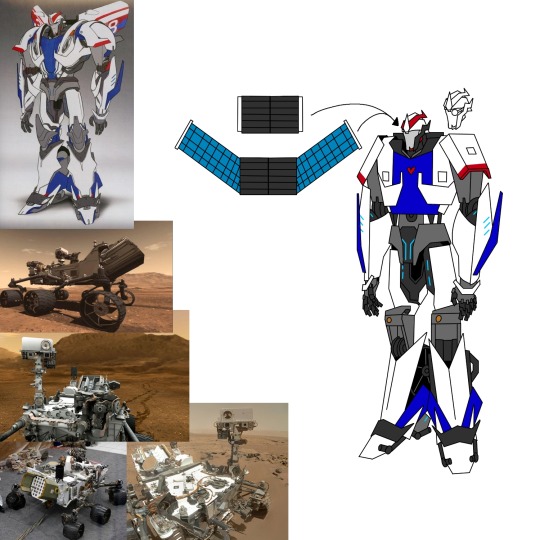
Yes he's boxy, so is the rover. Deal with it.
The rover used as a reference is Curiosity. Perseverance is a bit bigger and more streamline, but it was sent to Mars in 2020, so yeah.
I'm was very excited when I saw this AU because it combined both of my favorites things! Smokescreen and Mars!
By the way, here's some personal notes under the cut.
I did a lot of research when drawing this to make sure I got it pretty accurate. So first thing, here's the size reference:

Curiosity is the biggest one.
I imagine the Smokescreen having a rover alt-mode means he can use solar energy, instead of worrying about his small amount of energon. This means he goes eepy on his stomach so his wing/solar panels can soak up as much sun as possible.
Another thing, rovers make beep sounds, kinda like Bumblebee I guess. So Smokescreen beeps when he's surprised or excited. He doesn't do it as a way to speak, just as a vocal stim or reaction.
Oh, the round thing over his eye in the drawing is the camera. He'd be able to zoom in, record, and analyze with it. There are other devices in the rover that would allow him to detect radiation, elements, and do more in depth analytics.
All this makes me feel like he'd be placed to work with Ratchet if he ever got to Earth. He'd probably still have his weapon, but I still feel like he'd slowly start leaning towards a scientist like life. Oooo! The rovers could be his mini helpers!
31 notes
·
View notes
Text

youtube
NASA's Perseverance Rover Sees Solar Eclipse on Mars
NASA’s Perseverance Mars rover used its Mastcam-Z camera system to shoot video of Phobos, one of Mars’ two moons, eclipsing the Sun. It’s the most zoomed-in, highest frame-rate observation of a Phobos solar eclipse ever taken from the Martian surface.
Several Mars rovers have observed Phobos crossing in front of the Sun over the past 18 years. Spirit and Opportunity made the first observations back in 2004; Curiosity in 2019 was the first to record video of the event. Each time these eclipses are observed, they allow scientists to measure subtle shifts in Phobos’ orbit over time. The moon’s tidal forces pull on the deep interior of the Red Planet, as well as its crust and mantle; studying how much Phobos shifts over time reveals something about how resistant the crust and mantle are, and thus what kinds of materials they’re made of.
The Mars 2020 Perseverance mission is part of NASA’s Moon to Mars exploration approach, which includes Artemis missions to the Moon that will help prepare for human exploration of the Red Planet.
Credit: NASA/JPL-Caltech/ASU/MSSS/SSI
#Mars#Phobos#solar eclipse#eclipse#space#astronomy#astrophotography#Perseverance rover#NASA#religion is a mental illness#Youtube
31 notes
·
View notes
Text
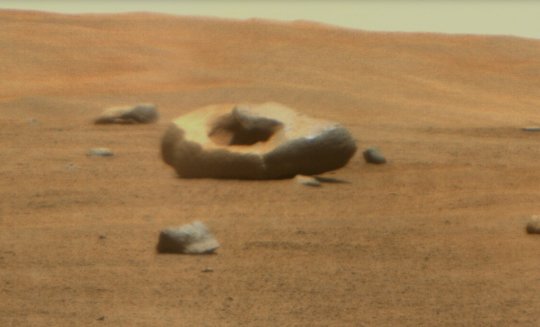

Perseverance discovers a doughnut-shaped rock on Mars
NASA's Perseverance Mars rover captured this doughnut-shaped rock in Jezero Crater from about 328 feet (100 meters) away using its Remote Microscopic Imager (RMI), part of the SuperCam instrument, on June 22, 2023, the 832nd Martian day, or sol, of the mission.
Oddly shaped rocks aren't uncommon, either on Earth or Mars; they're often formed over eons as winds sandblast rock faces. This particular rock may have formed after a smaller rock (or multiple rocks) eroded near its center. That left behind a cavity that was later enlarged by the wind.
The figure below shows the same rock in its broader context, when it was first spotted by the rover's Mastcam-Z instrument from about 1,312 feet (400 meters away) on April 15, 2023, the 765th Martian day, or sol, of the mission.
SuperCam is led by Los Alamos National Laboratory in New Mexico, where the instrument's body unit was developed. That part of the instrument includes several spectrometers as well as control electronics and software. The mast unit, including RMI, was developed and built by several laboratories of the CNRS (the French research center) and French universities under the contracting authority of Centre National d'Études Spatiales (CNES), the French space agency.
Arizona State University leads the operations of the Mastcam-Z instrument, working in collaboration with Malin Space Science Systems in San Diego, on the design, fabrication, testing, and operation of the cameras, and in collaboration with the Niels Bohr Institute of the University of Copenhagen on the design, fabrication, and testing of the calibration targets.
A key objective for Perseverance's mission on Mars is astrobiology, including the search for signs of ancient microbial life. The rover will characterize the planet's geology and past climate, pave the way for human exploration of the Red Planet, and be the first mission to collect and cache Martian rock and regolith (broken rock and dust).
Subsequent NASA missions, in cooperation with ESA (European Space Agency), would send spacecraft to Mars to collect these sealed samples from the surface and return them to Earth for in-depth analysis.
The Mars 2020 Perseverance mission is part of NASA's Moon to Mars exploration approach, which includes Artemis missions to the Moon that will help prepare for human exploration of the Red Planet.
#science#space#astronomy#physics#news#nasa#starstuff#spacetimewithstuartgary#spacetime#mars perseverance rover
19 notes
·
View notes
Text



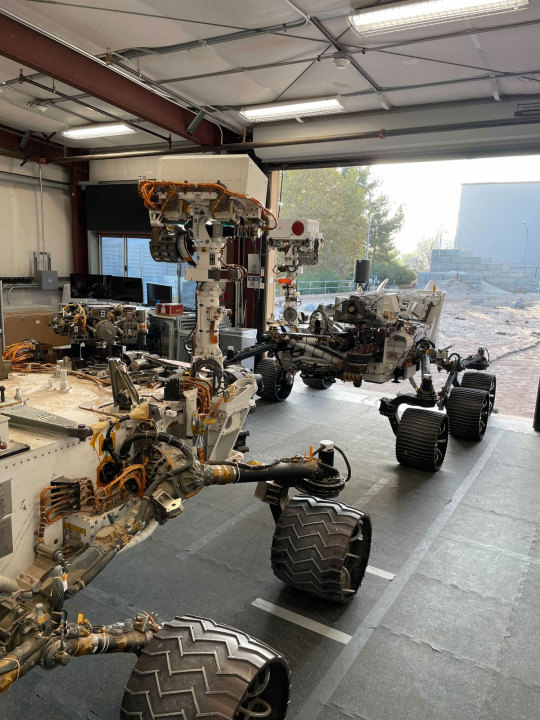
OPTIMISM – Operational Perseverance Twin for Integration of Mechanisms and Instruments Sent to Mars (2020), Jet Propulsion Laboratory (JPL), Pasadena, CA. This Vehicle System Test Bed (VSTB) is the Earth-side counterpart of the Perseverance rover that landed on Mars in 2021. The last photo shows OPTIMISM nose-to-nose with MAGGIE (foreground) at the JPL Mars Yard, where they simulate how the hardware and software will perform before they transmit commands to Mars. It's particularly useful for testing software patches before sending updates to Perseverance. Don't worry though – it's not running Windows, but the VxWorks Real-Time Operating System (RTOS). "The Mars 2020 Perseverance test bed team's motto is 'No optimism allowed'. So we named the test rover OPTIMISM to remind us of the work we have to do to fully test the system. Our job is to find problems, not just hope activities will work. As we work through the issues with OPTIMISM, we gain confidence in Perseverance's capabilities and confidence in our ability to operate on Mars." – Matt Stumbo, VSTB lead.
117 notes
·
View notes
Text
Plant Grows From Rock On Latest Mars Photo! UFO Sighting News. Video, please subscribe to my channel for more.
Date of discovery: April 5, 2023
Location of discovery: Mars
Source photo: https://mars.nasa.gov/mars2020/multimedia/raw-images/ZR0_0754_0733878091_081EBY_N0371798ZCAM08760_1100LMJ

I found this pink and green plant growing from a rock on Mars, its one of the latest Mars Perseverance rover photos so its 100% news stuff. I have reported a white rose on Mars I found back in 2020, but this one being two colors and close up is just mind-blowing. Now you know why NASA puts most photos into false-color. To hide the truth from the public. 100% proof that life exists on planet Mars right now!
youtube
Scott C. Waring - Taiwan
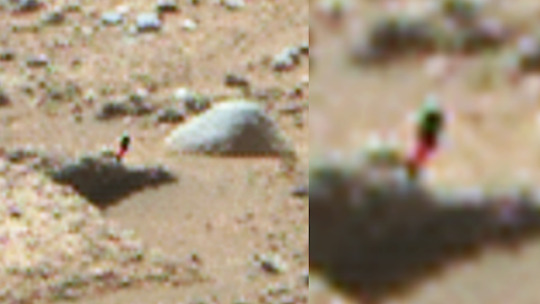
3 notes
·
View notes
Text
Artemis: why it may be the last mission for Nasa astronauts
by Martin Rees, Emeritus Professor of Cosmology and Astrophysics at the University of Cambridge

Neil Armstrong took his historic “one small step” on the Moon in 1969. And just three years later, the last Apollo astronauts left our celestial neighbour. Since then, hundreds of astronauts have been launched into space but mainly to the Earth-orbiting International Space Station. None has, in fact, ventured more than a few hundred kilometres from Earth.
The US-led Artemis programme, however, aims to return humans to the Moon this decade – with Artemis 1 on its way back to Earth as part of its first test flight, going around the Moon.
The most relevant differences between the Apollo era and the mid-2020s are an amazing improvement in computer power and robotics. Moreover, superpower rivalry can no longer justify massive expenditure, as in the Cold War competition with the Soviet Union. In our recent book “The End of Astronauts”, Donald Goldsmith and I argue that these changes weaken the case for the project.
The Artemis mission is using Nasa’s brand new Space Launch System, which is the most powerful rocket ever – similar in design to the Saturn V rockets that sent a dozen Apollo astronauts to the Moon. Like its predecessors, the Artemis booster combines liquid hydrogen and oxygen to create enormous lifting power before falling into the ocean, never to be used again. Each launch therefore carries an estimated cost of between $2 billion (£1.7 billion) and $4 billion.
This is unlike its SpaceX competitor “Starship”, which enables the company to recover and the reuse the first stage.
The benefits of robotics
Advances in robotic exploration are exemplified by the suite of rovers on Mars, where Perseverance, Nasa’s latest prospector, can drive itself through rocky terrain with only limited guidance from Earth. Improvements in sensors and artificial intelligence (AI) will further enable the robots themselves to identify particularly interesting sites, from which to gather samples for return to Earth.
Within the next one or two decades, robotic exploration of the Martian surface could be almost entirely autonomous, with human presence offering little advantage. Similarly, engineering projects – such as astronomers’ dream of constructing a large radio telescope on the far side of the Moon, which is free of interference from Earth – no longer require human intervention. Such projects can be entirely constructed by robots.
Instead of astronauts, who need a well equipped place to live if they’re required for construction purposes, robots can remain permanently at their work site. Likewise, if mining of lunar soil or asteroids for rare materials became economically viable, this also could be done more cheaply and safely with robots.
Robots could also explore Jupiter, Saturn and their fascinatingly diverse moons with little additional expense, since journeys of several years present little more challenge to a robot than the six-month voyage to Mars. Some of these moons could in fact harbour life in their sub-surface oceans.
Even if we could send humans there, it might be a bad idea as they could contaminate these worlds with microbes form Earth.
Managing risks
The Apollo astronauts were heroes. They accepted high risks and pushed technology to the limit. In comparison, short trips to the Moon in the 2020s, despite the $90-billion cost of the Artemis programme, will seem almost routine.
Something more ambitious, such as a Mars landing, will be required to elicit Apollo-scale public enthusiasm. But such a mission, including provisions and the rocketry for a return trip, could well cost Nasa a trillion dollars – questionable spending when we’re dealing with a climate crisis and poverty on Earth. The steep price tag is a result of a “safety culture” developed by Nasa in recent years in response to public attitudes.
This reflects the trauma and consequent programme delays that followed the Space Shuttle disasters in 1986 and 2003, each of which killed the seven civilians on board. That said, the shuttle, which had 135 launches altogether, achieved a failure rate below two percent. It would be unrealistic to expect a rate as low as this for the failure of a return trip to Mars – the mission would after all last two whole years.
Astronauts simply also need far more “maintenance” than robots – their journeys and surface operations require air, water, food, living space and protection against harmful radiation, especially from solar storms.
Already substantial for a trip to the Moon, the cost differences between human and robotic journeys would grow much larger for any long-term stay. A voyage to Mars, hundreds of times further than the Moon, would not only expose astronauts to far greater risks, but also make emergency support far less feasible. Even astronaut enthusiasts accept that almost two decades may elapse before the first crewed trip to Mars.
There will certainly be thrill-seekers and adventurers who would willingly accept far higher risks – some have even signed up for a proposed one-way trip in the past.
This signals a key difference between the Apollo era and today: the emergence of a strong, private space-technology sector, which now embraces human spaceflight. Private-sector companies are now competitive with Nasa, so high-risk, cut-price trips to Mars, bankrolled by billionaires and private sponsors, cold be crewed by willing volunteers. Ultimately, the public could cheer these brave adventurers without paying for them.
Given that human spaceflight beyond low orbit is highly likely to entirely transfer to privately-funded missions prepared to accept high risks, it is questionable whether Nasa’s multi-billion-dollar Artemis project is a good way to spend the government’s money. Artemis is ultimately more likely to be a swansong than the launch of a new Apollo era.
#science#artificial intelligence#NASA#Astronauts#space exploration#Artemis program#Artemis 1#Artemis mission#featured#science news
5 notes
·
View notes
Text
First 360° video of the Rover Perseverance on Mars, in 2020
2 notes
·
View notes
